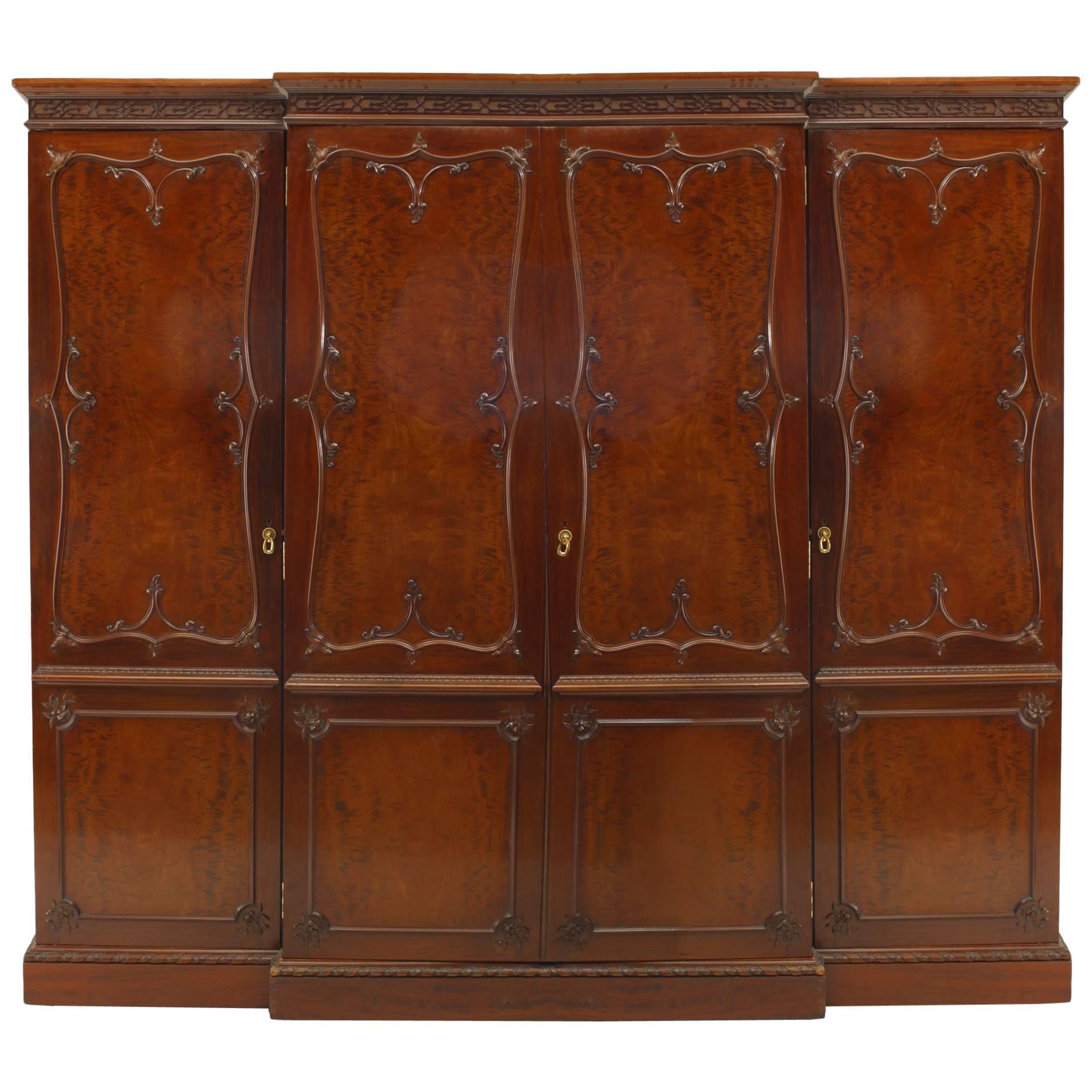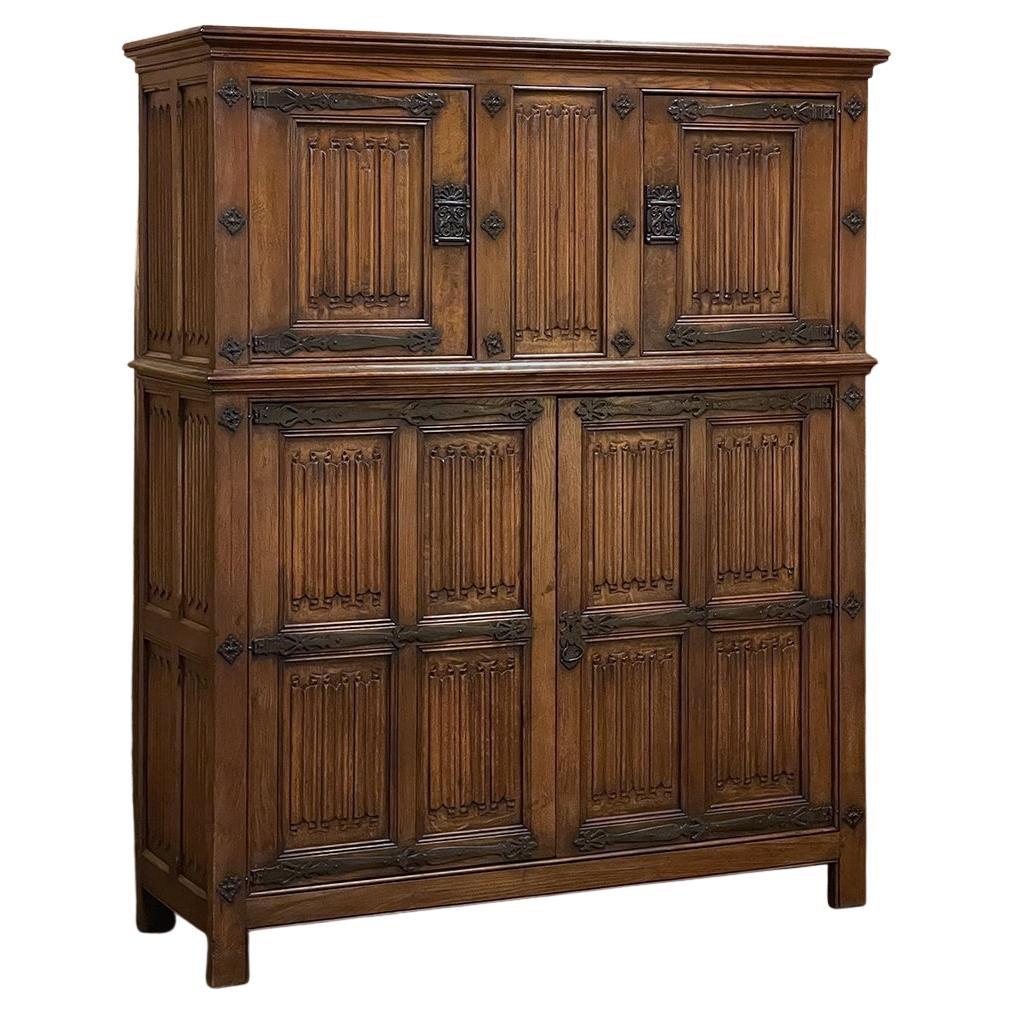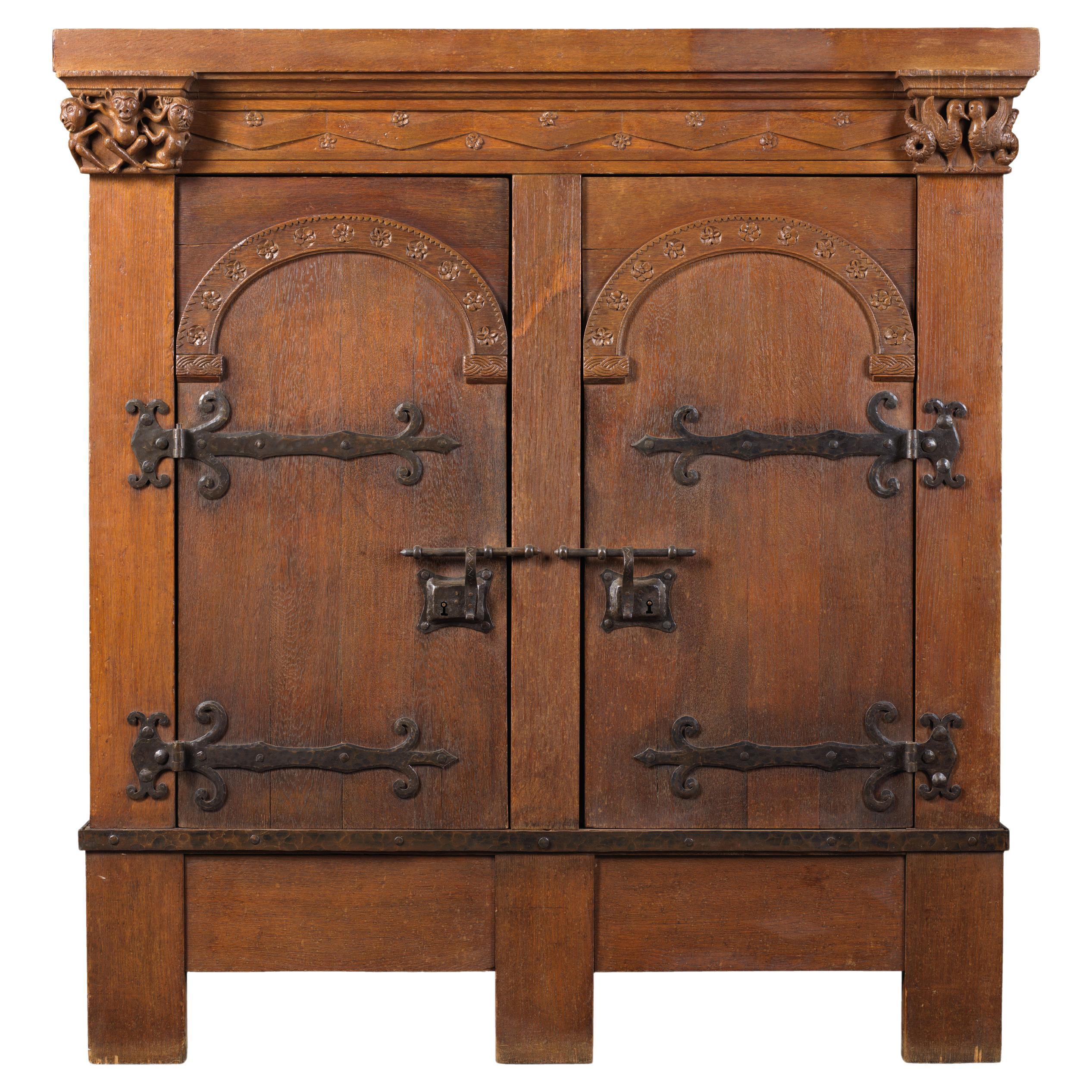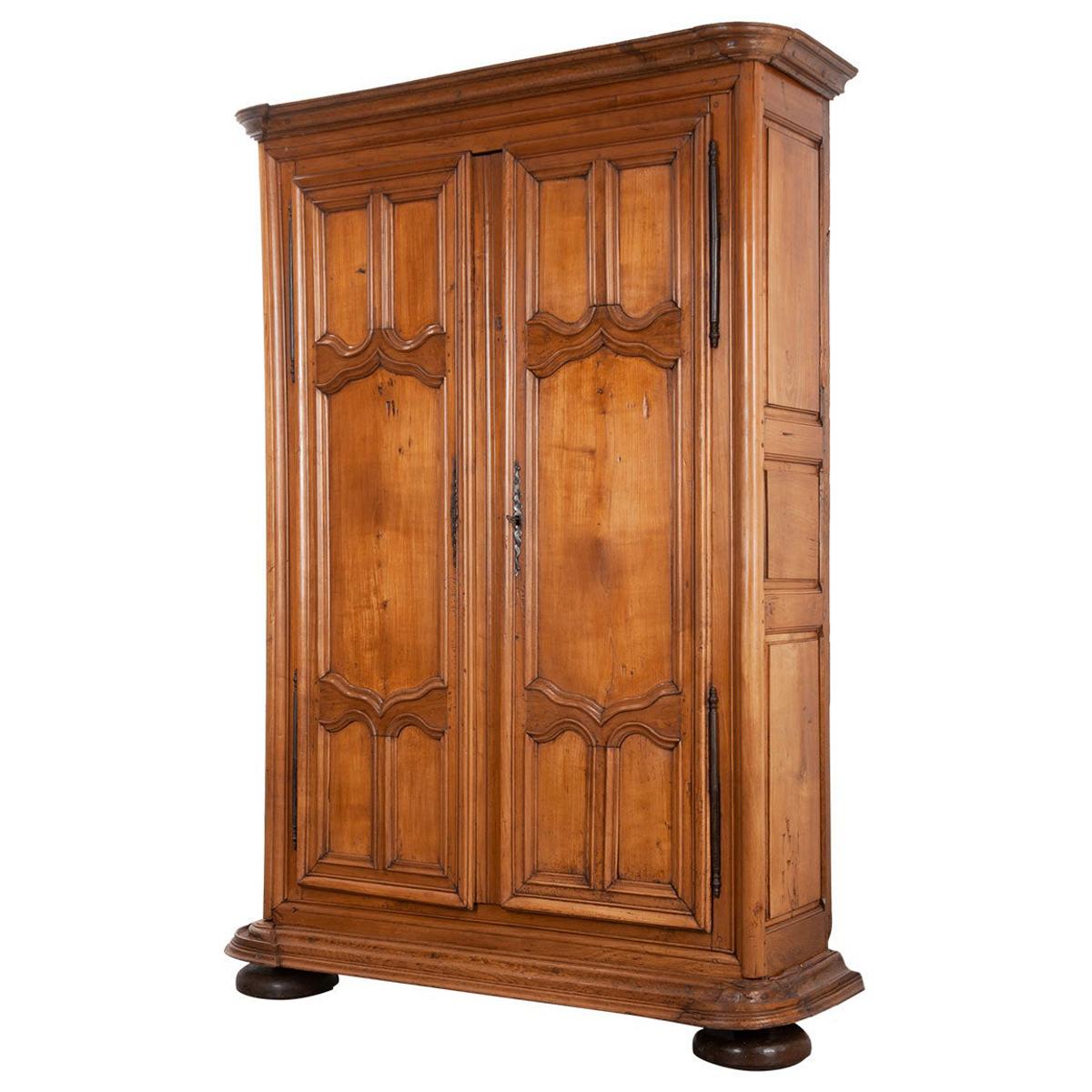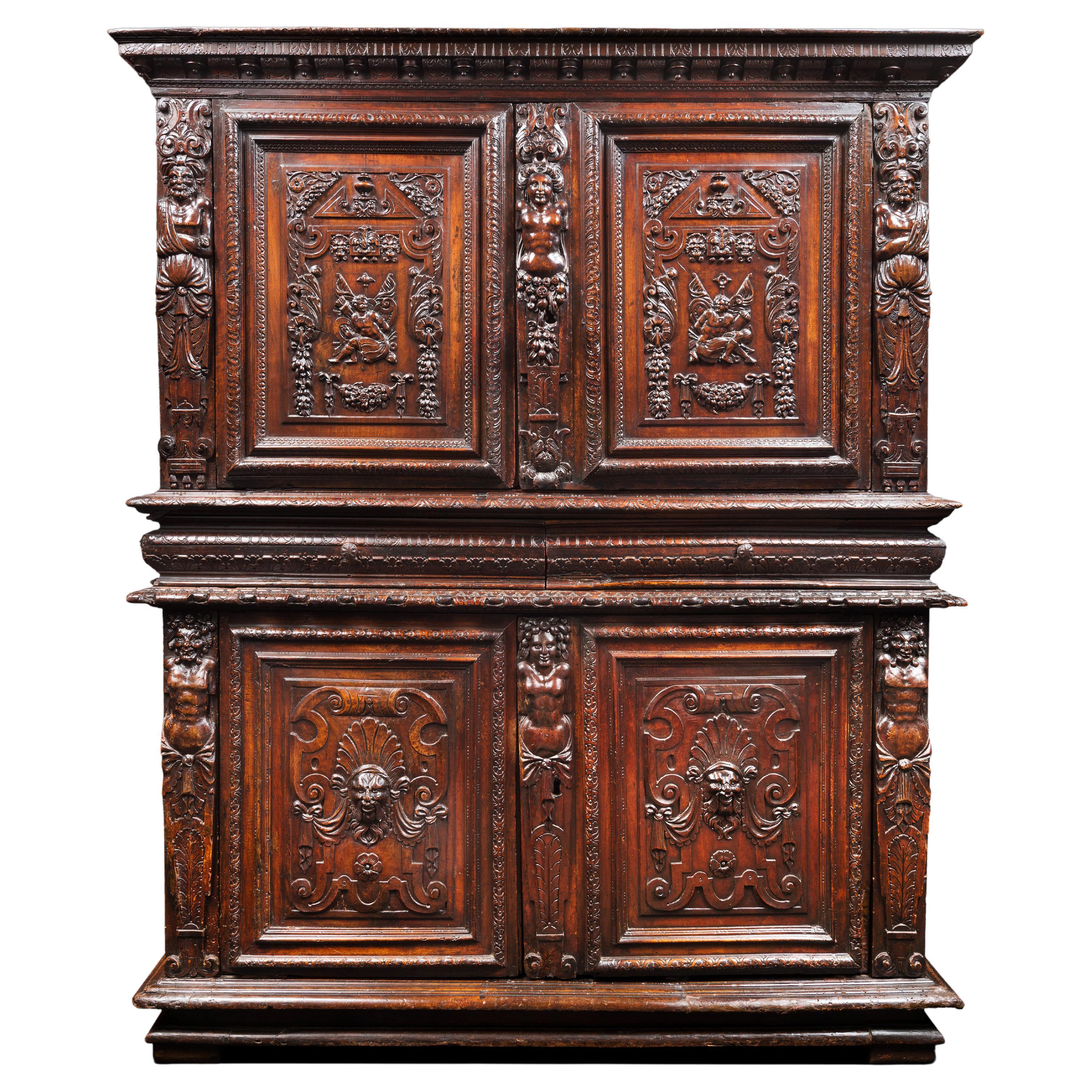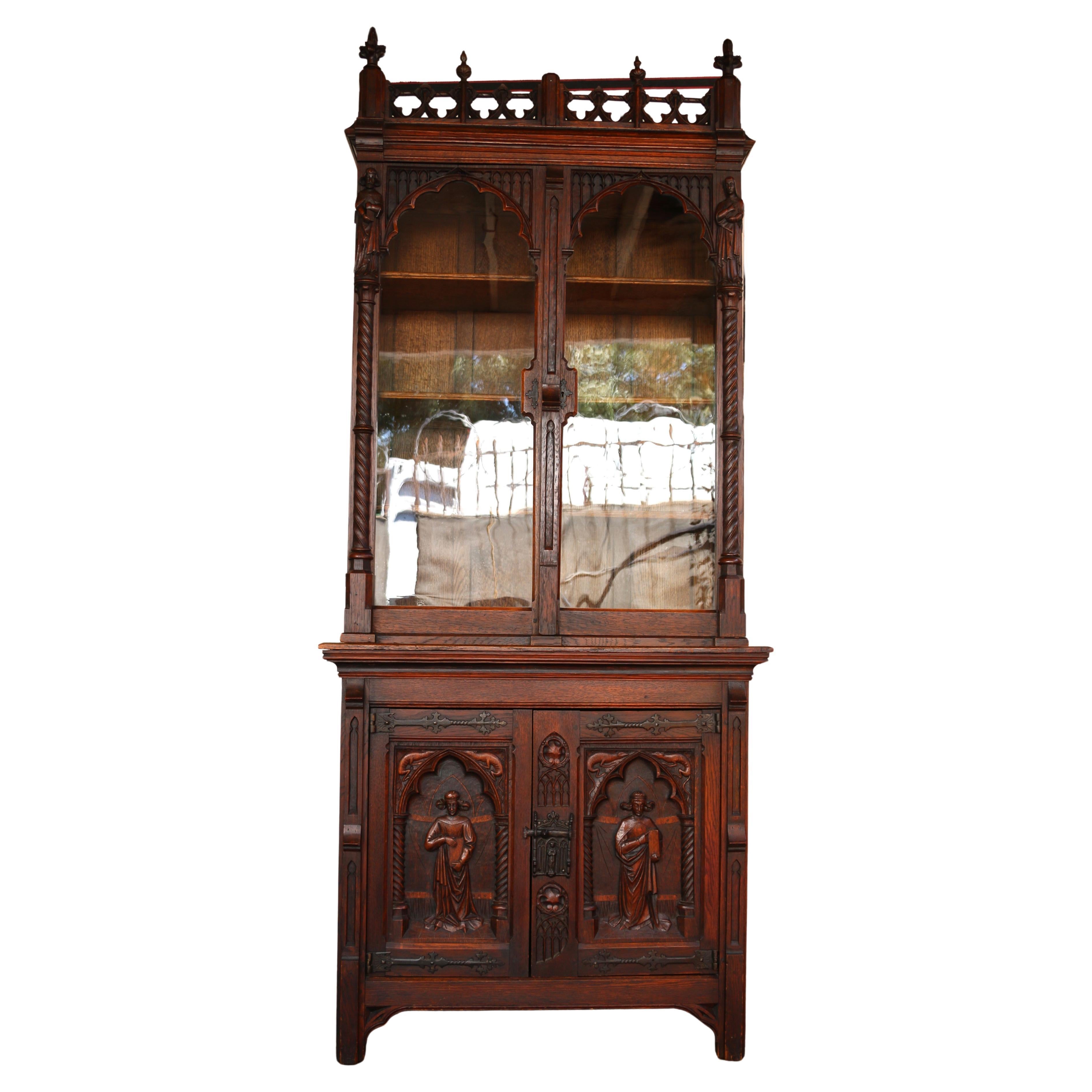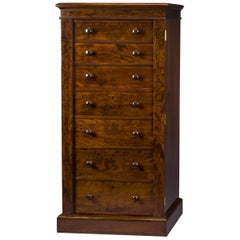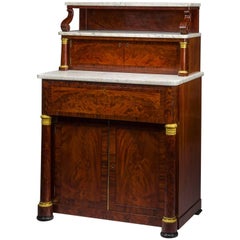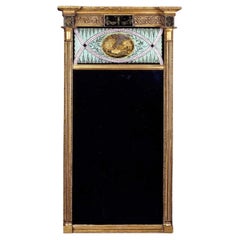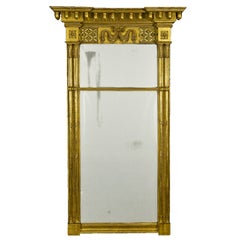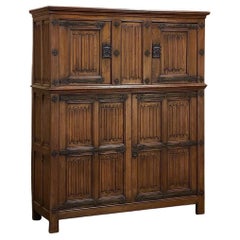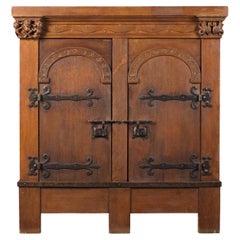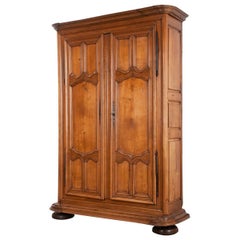Want more images or videos?
Request additional images or videos from the seller
1 of 6
Gothic Armoire
$125,000
£94,742.83
€109,674.10
CA$176,467.52
A$196,510.65
CHF 102,602.69
MX$2,381,090.68
NOK 1,293,928.40
SEK 1,220,923.43
DKK 818,704.28
About the Item
FAPG 19959D/2
Gothic Revival armoire
New York, about 1835-1840
Mahogany, with brass hardware
Measure: 104 in. high, 73 in. wide, 30 in. deep
Exhibited: Hirschl & Adler Galleries, New York, 2011–12, The World of Duncan Phyfe: The Arts of New York, 1800–1847, p. 89 no. 45 illus. 89
Ex coll.: Private collection (probably R. H. Selstadt, Big Stone Gap, Virginia)
Although no specific pieces of Gothic furniture documented as by Duncan Phyfe have come to light, there is considerable evidence that he, like various of his contemporaries in New York, embraced the Gothic style. For example, the catalogue of the Halliday & Jenkins auction sale of the contents of Phyfe’s furniture ware rooms, which was held on site at 192 and 194 Fulton Street, New York, on April 16 and 17, 1847, included a “mahogany centre table Gothic gilt pillar and Egyptian marble top” (Halliday & Jenkins, p. 3 no. 63); “12 mahogany Gothic chairs tufted seats” (p. 5 no. 102); “6 mahogany Gothic pattern Chairs” (ibid., p. 5 no. 106 [incorrectly given as 606]); “1 large mahogany Writing Table and Book Case, glass doors, Gothic top & c. (ibid., p. 9 no. 204); 1 very splendid rosewood Davenport Writing Desk, 4 tray Drawers, scroll standards, Gothic pannels [sic] and plate glass fronts, lined with wht silk” (ibid., p. 14 no. 291); “12 mahogany chairs. Gothic pattern” (p. 17 no. 353 [incorrectly numbered 453]); “and 1 mahogany cylinder fall desk and bookcase, glass doors, Gothic top” (ibid., p. 18 no. 375). Cumulatively, these and other similar entries suggest the Scope of Phyfe’s involvement in a style that became a significant force in American decorative arts, starting with some “survivals” of eighteenth century Gothic early in the nineteenth century, among them pointed and ogee arches on the glazed doors of secretary bookcases, which were certainly in use well before they appeared in The New-York Book of Prices of 1817, and escalating to considerable dominance in the 1830s and 1840s.
The present armoire, more ecclesiastical in aspect than much of the Gothic-revival furniture made in New York at this time, is a monumental piece where the two doors, together featuring a suite of four matching veneered panels each overlaid at the top by Gothic tracery, are flanked by a pair of attenuated clustered columns. The doors are capped by an applied molding that is like a “Gothicized” traditional egg and dart molding, and the whole piece is surmounted by an elaborate free–standing, openwork cornice composed of a variety of Gothic motifs. Its Gothic ornament notwithstanding, the piece still retains the aspect of a neoclassical armoire, the profile of the base and the cornice following a Meeksian or Grecian “pillar and scroll” aesthetic of the mid to late 1830s.
From the standpoint of craftsmanship, the armoire is a spectacular performance, beautifully made, and incorporating a splendid array of carefully selected solid mahogany and mahogany veneers. The columns at the right and left and the woods surrounding the veneered door panels are made of a rare striped mahogany that one sees throughout the work of Duncan Phyfe—likely the “zebra wood” referred to in the Halliday & Jenkins catalogue (pp. 4, no. 92, 14 no. 304, etc.)—and it is not beyond the realm of possibility that pieces such as this originated in the Phyfe shop.
Condition: Excellent. Cleaned and French polished. Minor veneer repairs throughout. Some of the interior drawer knobs have been replaced.
- Dimensions:Height: 104 in (264.16 cm)Width: 73 in (185.42 cm)Depth: 30 in (76.2 cm)
- Style:Gothic Revival (In the Style Of)
- Materials and Techniques:
- Place of Origin:
- Period:
- Date of Manufacture:circa 1840-1849
- Condition:Repaired. Condition: Excellent. Cleaned and French polished. Minor veneer repairs throughout. Some of the interior drawer knobs have been replaced.
- Seller Location:New York, NY
- Reference Number:Seller: FAPG 19959D/21stDibs: LU9032784546
About the Seller
No Reviews Yet
Recognized Seller
These prestigious sellers are industry leaders and represent the highest echelon for item quality and design.
Established in 1952
1stDibs seller since 2010
Associations
Art Dealers Association of America
- ShippingRetrieving quote...Shipping from: New York, NY
- Return Policy
Authenticity Guarantee
In the unlikely event there’s an issue with an item’s authenticity, contact us within 1 year for a full refund. DetailsMoney-Back Guarantee
If your item is not as described, is damaged in transit, or does not arrive, contact us within 7 days for a full refund. Details24-Hour Cancellation
You have a 24-hour grace period in which to reconsider your purchase, with no questions asked.Vetted Professional Sellers
Our world-class sellers must adhere to strict standards for service and quality, maintaining the integrity of our listings.Price-Match Guarantee
If you find that a seller listed the same item for a lower price elsewhere, we’ll match it.Trusted Global Delivery
Our best-in-class carrier network provides specialized shipping options worldwide, including custom delivery.More From This Seller
View AllSeven-Drawer Tall Chest of Drawers
Located in New York, NY
Boston, Massachusetts
Seven-drawer tall chest, circa 1825.
Mahogany (secondary woods: mahogany, pine, and poplar)
Measures: 45 5/8 in. high, 27 5/8 in. wide, 14 5/8 in. deep
Inscribed (on six drawer locks): SECURE; (on seventh lock): CHUBB’S / PATENT / 57 St PAULS CHY / LONDON / CHUBB & SON / MAKERS TO / HER MAJESTY / 632284; (on one hinge): [BUR?] NE PATENT; (on master lock): 2 LEVER.
Although some Boston furniture of the Neo-Classical period is elaborately decorated with ormolu mounts, brass moldings, and carved and gilded elements, other pieces are more simple and are said to reflect the “conservative” taste of many of Boston’s great families. The simplicity evident in these pieces is not an indication of a less-expensive line of furniture or a less-sophisticated patronage, but, like the so-called “Grecian Plain Style” of Duncan Phyfe’s furniture...
Category
Antique 1820s American Neoclassical Commodes and Chests of Drawers
Materials
Mahogany
Butler's Desk and Etagére, New York, Possibly Duncan Phyfe
By Duncan Phyfe
Located in New York, NY
Butler’s Desk and Etagére, circa 1825
New York, possibly by Duncan Phyfe
Mahogany (secondary woods: mahogany, pine, poplar), with ormolu mounts, marble,...
Category
Antique 1820s American Neoclassical Cabinets
Materials
Mahogany
Pier Mirror with Églomisé Panels
Located in New York, NY
Pier mirror with Reverse Painted, or Eglomisé, Panels, about 1800
New York, New York
Eastern white pine, gessoed and gilded, with compo ornament, glass, reverse painted and gilded,...
Category
Antique Early 1800s American American Classical Pier Mirrors and Console...
Materials
Glass, Wood
Pier Mirror in the Neoclassical Taste
Located in New York, NY
New York, circa 1815-1820.
Wood, gessoed and gilded, with mirror plate.
75 1/2 in. high, 44 1/8 in. wide (at the cornice), 8 1/2 in. deep (at the cornice).
Condition: Some restorati...
Category
Antique 19th Century American Neoclassical Pier Mirrors and Console Mirrors
Materials
Mirror, Wood
Monumental Overmantel or Pier Mirror in the Aesthetic Taste
Located in New York, NY
American, third quarter of the 19th century.
Pine, gessoed and gilded, with mirror plate.
Measures: 81 ½ in. high, 59 ½ in. wide.
Condition: Excellent. The gilding has been cleaned and very, very slightly inglided as necessary. The ball at the upper left was missing and has been replicated based upon...
Category
Antique 19th Century American Aesthetic Movement Pier Mirrors and Consol...
Materials
Mirror, Pine
Fan-Carved Wood Mantel in the Federal Taste
Located in New York, NY
New York,
Fan-carved mantel in the Federal taste, circa 1812
Pine
Measures: 66 1/4 in. high, 90 3/8 in. wide, 13 1/4 in. deep
Within the genre of carved rather than plasterwork mantels of the Federal Period, no example that has come to light is more perfectly designed or more carefully wrought than the present one, which is an amazing symphony of fans, urns, beads, and other Neo-Classical devices, all ultimately influenced by the plasterwork designs of the English architects Robert (1728–1792) and James (1732–1794) Adam.
Of a type that proliferated in the area bounded by the northern New Jersey counties of Bergen and Passaic, the Hudson Valley, and western Long Island, the mantel is representative of work that flourished in the first couple of decades of the 19th century. While most of the woodwork of this style that has survived is found in interiors, various examples of exterior doors and other trim have been noted, but most examples have disappeared as a result, variously, of natural deterioration and purposeful demolition in anticipation of development.
Although considerably larger in scale and more elaborate in ornament than a mantel that has been in the collection of the Brooklyn Museum since 1944 (acc. no. 44.55; photograph in Hirschl & Adler archives), the present mantel is so close in style and conception to that example that it likely originated in the same house.
The Brooklyn mantel is documented as having been removed from a house built by Judge Isaac Terhune (1762–1837), an eminent lawyer and judge. The house was situated on King’s Highway, at the corner of Mansfield Place, at the edge of South Greenfield, a village in northern Gravesend, Brooklyn. A photograph of the house, taken by the German e´migre´ photographer, Eugene Armbruster (1865–1933), is in the collection of the New-York Historical Society.
Terhune is ultimately descended from the Dutch-Huguenot e´migre´ Albert Albertson Terhunen, who died in Flatlands, Brooklyn, in 1685.The family eventually spread out through New Amsterdam, Long Island, and Bergen County, New Jersey. Terhune’s great-grandson, also Albert (1715–1806), left a sizable estate to his six surviving children, including his second child and second son, Isaac.
Judge Terhune lived in the house until his death in 1837, at which time, according to an article in The New York Times for November 27, 1910, he, having died without issue, “left the White Frame Mansion with its exquisitely carved doorway, beautiful mantels, and other interior adornments to his brother John” (Part Six, p. 11).
The article continues:
After the latter’s death, the house and its estate of about 70 acres passed through several owners, eventually being purchased in 1853 by Benjamin G. Hitchings [1813–1893].
The house next passed to Benjamin’s son, Hector, who had been born in the house, and then lived there for 25 years. He sold it in 1910 in partial payment for a Manhattan apartment house. After thus having been sold to a real estate developer, the Hitchings property was subdivided into Hitchings Homestead. The house survived until about 1928, at which time it was razed and a Deco-style apartment house with the address 2301 Kings Highway was constructed on the site and occupied in 1935.
By 1910, the fate of the house, in an area of Brooklyn that was being rapidly developed, was becoming obvious. The Times article reported:
The house has been well kept up, but fearing lest the hand of time or vandals might deal harshly with some of its choice bits of carving, Mr. Hitchings removed a few years ago a few beautifully carved wood mantels...
Category
Antique 1810s American Neoclassical Fireplaces and Mantels
Materials
Wood
You May Also Like
English Victorian Mahogany Armoire
Located in Queens, NY
English Victorian mahogany armoire cabinet with 4 doors have a carved design framing a burl wood panel with a fretwork design cornice
Category
20th Century Victorian Wardrobes and Armoires
Materials
Mahogany
Antique French Gothic Wardrobe, Cabinet
Located in Dallas, TX
Antique French Gothic wardrobe ~ cabinet is an intriguing example of the style, with no less than 23 hand-carved linenfold panels combining with ...
Category
Early 20th Century French Gothic Revival Wardrobes and Armoires
Materials
Iron
Gothic Revival Apothecary Cabinet
Located in Saint-Ouen, FR
Wooden apothecary cabinet with carved decoration in neo-Gothic style. The capitals are carved with Baphomets holding two figures by the hair for one and fantastic birds for the other...
Category
Early 20th Century European Gothic Revival Wardrobes and Armoires
Materials
Oak
French 18th Century Gothic Armoire
Located in Baton Rouge, LA
This 18th century, mixed wood French armoire is absolutely stunning. It is Gothic-style and features two tall, paneled doors on barrel hinges. One key operates the locking right door...
Category
Antique 18th Century French Gothic Wardrobes and Armoires
Materials
Wood
French Renaissance Armoire
Located in Saint-Ouen, FR
Original lock and key
This piece of furniture shows no recess on its upper part. It opens with four folding-doors and two drawers within the belt. The key bears the date 1524 above cross motifs.
Burgundy and Lyon regions subordinated themselves to architecture in a different manner than the other french schools. Rather than using particularly columns and pediments pieces of furniture from Lyon borrow architecture’s organization principles and rigorous designs.
On the upper body a strong feeling of balance and symmetry appears with the folding doors reliefs. Swags of flowers and fruits held with knot cloth centered by a man seating on his arms. Here profiles, masks and chou de Bourgogne mingle with the structuring scrolls. The two lateral terms wear draperies and the goddess Diana in the center wears a belt of fruits similar to Hugue Sambin’s designs (Termes de Diane et de Venus, 1554, BNF).
The two palm-leaves enriched drawers and the alternating scrolls belt balance the weight of the cornice with its alternatings consoles and tops.
The lower body is also adorned by three terms with a feminine one in the center, all three are wearing fruits on their heads. The folding doors are centered upon a motif of cut cuirs by a mask in high relief. Wearing a feathered tiara...
Category
Antique 16th Century French Renaissance Wardrobes and Armoires
Materials
Walnut
$94,862
Gothic Revival Two Pieces Hunt Cabinet
Located in North Hollywood, CA
Stunning Gothic Revival oak cabinet. The carved saints at the upper corners, ogee arch shape of the glass panes on the upper doors and in the carvings on the lower doors, the quarter...
Category
Antique Early 1800s French Gothic Revival Buffets
Materials
Metal
More Ways To Browse
Cane Or Wicker Armoire
Antique Revival Furniture
Antique Gothic
Gothic Antique Furniture
Gothic Wood Furniture
Antique Gothic Door
Antique Gothic Chairs
Antique Door Knob Brass
Egypt Cabinet
Cluster Column
French Gothic Doors
French Gothic Cabinet
Egyptian Mahogany
American Wood Secretary
Antique Gothic Desk
Antique American Two Door Cabinet
Pillar And Scroll
Gothic Wood Chair
